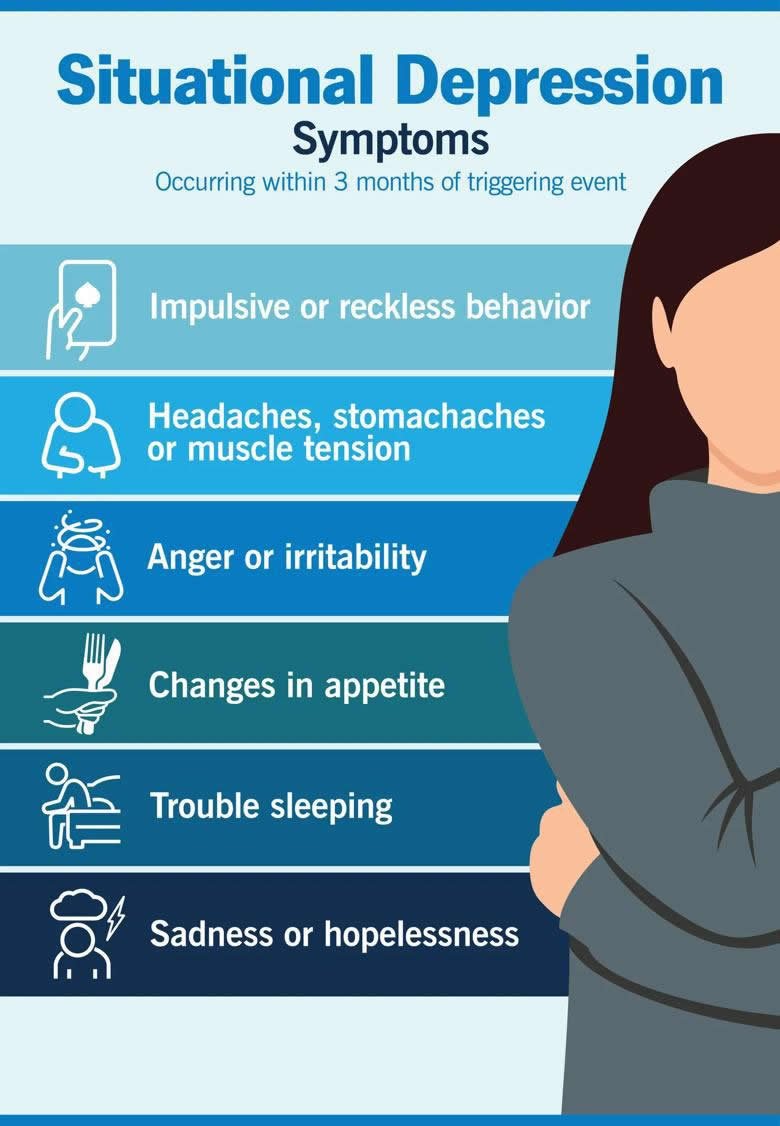Understanding Situational Depression
Major life events and trying times can trigger reactive depression symptoms, like prolonged sadness, irritability and hopelessness

We all go through hard times in life. And when those events are stressful, painful or downright awful, it can be tough to see a way out of it.
Situational depression can arise from those trying times.
Clinical psychologist Dawn Potter, PsyD, shares advice for managing emotional turmoil and keeping it from lingering.
What is situational depression?
Situational depression, also known as reactive depression, describes a strong emotional response in reaction to a triggering life event, like the loss of a loved one or a natural disaster.
“Situational depression isn’t a medical diagnosis, but it may be described by mental health professionals as adjustment disorder with depressed mood,” Dr. Potter clarifies. “It means that a stressor in your life has triggered a larger-than-expected emotional response that impacts your overall well-being.”
Reactive depression goes beyond typical grief. It’s expected to experience a certain amount of emotional upheaval after a loss. But when you’re experiencing situational depression, you have a stronger reaction to the triggering event.
It’s also different from clinical depression (major depression). Situational depression creeps up within three months of a triggering event, while clinical depression isn’t necessarily in response to anything.
Usually, people with situational depression will notice mood improvements a few days or weeks after the stressful event has ended or as time passes. But if the event continues, or if reactive depression isn’t fully addressed, it could turn into clinical depression down the road.
What causes situational depression?
Any big or stressful life event or circumstance can lead to situational depression. Examples include things like:
- The death of a loved one or pet
- Losing a job or starting a new one
- A divorce or romantic breakup
- A troubling medical diagnosis
- Experiencing trauma, like an accident, a crime or a natural disaster
- Family problems
- Troubles at work or school
Even seemingly positive changes in your life, like retiring or having a baby, can cause stress and anxiety that lead to reactive depression.
It may not be one thing that triggers an adjustment disorder. Sometimes, the stress of everyday life builds up, like a pressure cooker. When one more trouble arises, it becomes too much.
But not everyone who experiences stressful or trying situations shows signs of reactive depression — and the severity of the situation doesn’t determine how people will respond. It’s an individual, personal reaction that’s based on factors like your:
- Resiliency
- Support system
- Life experiences
- Cultural norms
- Genetics
“What triggers an adjustment disorder can vary greatly,” Dr. Potter confirms. “We all have a different threshold for how we cope and adjust in times of stress, change or loss.”
Symptoms of reactive depression

Situational depression can look different for different people, but typical symptoms include:
- Sadness and grief
- Hopelessness
- Constant fear or worry
- Trouble focusing or sleeping
- Anger or irritability
- Changes in appetite
- Loss of interest in normal activities
- Trouble carrying out usual tasks
- Feeling overwhelmed
- Frequent crying
- Impulsive or reckless behavior, like drinking alcohol in excess, gambling or risky sexual behaviors
- Physical effects, like frequent or severe headaches, stomachaches, muscle tension or irregular heartbeat
Again, these can all be expected symptoms of grief following a major change in your life. They can also be signs of major depression and other mental health conditions.
“The difference lies in the severity of your symptoms, how long they last, when they started and how they impact your overall well-being,” Dr. Potter explains.
Managing situational depression
Making deliberate lifestyle changes can help you cope with situational depression, Dr. Potter advises. Try these strategies:
- Eat well. A healthy, balanced diet can help keep your body and mind working and feeling their best.
- Make sleep a priority. Keeping some sort of structured routine can make you feel more structured and in charge of your life. Try to keep a consistent schedule for going to sleep and waking up.
- Move your body. From weight loss to brain health and happy hormones, there are many reasons to be active and exercise. Sometimes, a brisk walk is enough to get the endorphins flowing.
- Spend time in nature. Being outdoors can help you feel more relaxed and recharged.
- Write down your thoughts. Getting your thoughts out on paper can be cathartic. Try the “hot pen” method — write whatever comes to mind for however long you need. Don’t worry about grammar, spelling or even whether it makes sense. Afterward, keep it or shred it.
- Practice meditation and breathing exercises. Repeating and meditating on a mantra, like “I am peaceful and calm,” for just 15 minutes, four or five days a week, can help combat negative thoughts.
- Take time to sit with your feelings. If you feel sadness or anger, think about where you feel them. Maybe it’s a heaviness in your chest or on your shoulders. That can help you acknowledge your feelings, honor them and manage them.
Sharing your story with someone who isn’t personally involved can help, too. If you’re noticing that your situational depression seems to be lasting for several weeks with no real breakthroughs, it might be time to talk with a mental health provider. A professional therapist can help you identify healthy coping mechanisms and find a way through situational depression.
“You don’t have to do it alone — and you don’t have to stay stuck in the hard part,” Dr. Potter reassures. “Even in life’s hardest moments, healing is possible with the right support and coping strategies.”